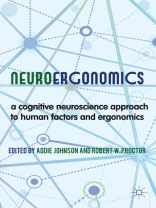This book covers the foundations and successes of Neuroergonomics, combining neuroscience and ergonomics to enhance efficiency and safety. An overview of the essential areas within the field is given including chapters on brain networks, perception, attention, and performance.
Spis treści
List of Tables List of Figures Preface Acknowledgements List of Contributors List of Abbreviations Prologue; Waldemar Karwowski PART I: THE WORKING BRAIN; Addie Johnson, Jacob Jolij, Raja Parasuraman & Paolo Toffanin 1. Brain Structures and Networks 2. A Default Mode of Brain Function 3. Assessing and Influencing Brain Function 4. Transcranial Magnetic Stimulation and Transcranial Direct Current Stimulation 5. Functional Near Infrared Spectroscopy 6. Electroencephalography 7. Information Processing in the Brain 8. Perception 9. Working Memory 10. Attention and Arousal 11. Decision Making 12. Action and Motor Control 13. Emotion and Social Interaction 14. Prediction of Prospective Activity 15. Direct Augmentation of Human Performance PART II: COGNITIVE NEUROERGONOMICS OF PERCEPTION; Jacob Jolij, Addie Johnson & Robert W. Proctor 16. Visual Processing 17. Top-down and Bottom-up Processing in Perception 18. Learning to See 19. Auditory Perception and Sonification 20. Touch and the Displayof Haptic Information 21. Multimodal Perception 22. Perception of Space and Self 23. Perceptual Docking for Robotic Control PART III: VISUAL ATTENTION AND DISPLAY DESIGN; Jason S. Mccarley & Kelly S. Steelman 24. Modes of Orienting 25. Why is Mental Processing Selective? 26. Perceptual Selection 27. Central Selection 28. Applications to Display Design 29. Visual Search 30. Grouping and Object Displays 31. Head-up and Head-mounted Displays 32. Large Scale Attention PART IV: ATTENTIONAL RESOURCES AND CONTROL; Paolo Toffanin & Addie Johnson 33. Quantifying and Describing Attention 34. Eye Movements and Pupil Diameter 35. Electroencephalography 36. Brain Networks and f MRI 37. Functional Near Infrared Spectroscopy 38. Augmented Interaction 39. Brain-computer Interfaces 40. Adaptive Interfaces 41. Augmenting Attention and Cognition 42. Enhancing Attention Through Training 43. Using Drugs to Enhance Attention PART V: PERFORMANCE MONITORING AND ERROR-RELATED BRAIN ACTIVITY; Addie Johnson & Rasa Gulbinaite 44. Performance Monitoring 45. Neural Correlates of Performance Monitoring 46. Error- and Feedback-related Processing 47. Error Prediction 48. Applications Based on Error-related and Feedback-related Neural Signals 49. Maintaining Attentional Control 50. Learning from Errors 51. On-line Classification of Feedback Processing PART VI: NEUROERGONOMICS OF SLEEP AND ALERTNESS; Jon Tippin, Nazan Aksan, Jeffrey Dawson & Matthew Rizzo 52. The Neurobiology of Sleep and Alertness 53. Sleepiness, Performance, and Sleepiness Countermeasures 54. Obstructive Sleep Apnea and Driving 55. Effects of Disordered Sleep on Arousal and Cognition 56. Self-awareness of Sleep Impairments 57. Impaired Sleep in OSA and Positive Airway Pressure Treatment 58. Assessing Naturalistic Driving Behaviour in the Real World 59. Case Study PART VII: AFFECTIVE AND SOCIAL NEUROERGONOMICS; Jacob Jolij & Yana Heussen 60. The Neural Basis Of Emotion 61. How Emotion Guides Vision and Cognition 62. Reading Emotional States 63. The Social Brain 64. Social Human-computer Communication and Interaction 65. Social Robotics PART VIII: NEUROERGONOMICS OF INDIVIDUAL DIFFERENCES IN COGNITION; Raja Parasuraman 66. Molecular Genetic Studies 67. Genomics 68. Why Look at Individual Differences? 69. A Theoretical Framework for the Molecular Genetics of Cognition 70. Visual Attention 71. Working Memory 72. Decision Making PART IX: VALIDATING MODELS OF COMPLEX, REAL-LIFE TASKS USING FMRI; Jelmer P. Borst, Niels A. Taatgen & Hedderik Van Rijn 73. Standard f MRI Analysis 74. Cognitive Architectures 75. Cognitive Architectures and f MRI 76. Task and Model 77. The Task 78. The Model 79. Regions-of-interest Analysis 80. Model-based f MRI Analysis 81. Applications to Task Design
O autorze
Nazan Aksan, Department of Neurology, University of Iowa, USA Jelmer Borst Carnegie Mellon University, USA Jeffrey D. Dawson, College of Public Health at the University of Iowa, USA Rasa Gulbinaite, University of Groningen, The Netherlands Yana Heussen, University Hospital Schleswig-Holstein, Germany Jacob Jolij, Department of Experimental Psychology of the University of Groningen, The Netherlands Waldemar Karwowski, P.E., University of Central Florida, USA Jason Mc Carley Flinders University, South Australia Raja Parasuraman Center of Excellence in Neuroergonomics, Technology, and Cognition (CENTEC) at George Mason University, USA Niels Taatgen, University of Groningen, The Netherlands Jon Tippin, University of Iowa Hospitals and Clinics and is director of the Sleep Disorders/EEG Laboratory at the Iowa City Veterans Affairs Medical Center, USA Paolo Toffanin, University of Groningen, The Netherlands Hedderik van Rijn has degrees in Cognitive Science from the University of Nijmegen andthe University of Amsterdam and has worked at the Max Planck Institute for Psycholinguistics and at Carnegie Mellon University, USA Matthew Rizzo, M.D., FAAN, directs the University of Iowa Aging Mind and Brain Initiative, USA Kelly S. Steelman, Flinders University, South Australia.












